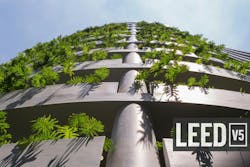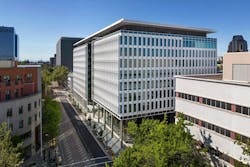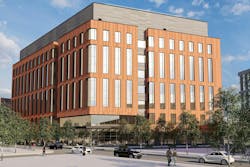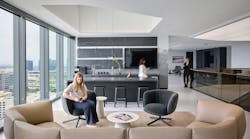An inside look at LEED v5 from one of its key architects
The latest version of USGBC’s LEED certification system is out for its second and final round of public comments before its anticipated publication in early 2025. LEED v5 emphasizes the urgency of addressing climate change and pushes the boundaries of green building in the architecture, engineering, and construction (AEC) industry.
In the following Q&A, Anica Landreneau, who is the director of HOK’s Sustainable Design practice and chair of the U.S. Green Building Council’s LEED Steering Committee, discusses the factors that influenced the development of LEED v5 and how the updated certification system will impact design and construction for years to come.
Why is there a need to update LEED?
As we’ve seen recently with Hurricanes Helene and Milton, the impact of climate change is real. The built environment is a significant contributor to global warming—responsible for up to 40% of carbon emissions. If we want to hit the goals of the Paris Agreement and limit average global temperature gain to below 1.5 degrees Celsius, our buildings need to be part of the solution.
They need to pollute less while also having the resiliency to adapt to a changing world and environment. LEED has been effective in pushing the design and construction industry forward and pulling regulatory bodies with it, leading to new codes and standards for sustainable design.
What’s new in LEED v5?
The top priority is rapid decarbonization to address the urgency of the climate crisis. Approximately half of the 110 points for achieving LEED v5 certification is based on decarbonization. That represents a much greater emphasis on decarbonization than ever before. Then a quarter of the points focus on biodiversity, ecology, and the natural world, which promotes resilience but also the survival of all species on the planet. Another quarter of the points focus on human health and well-being—the quality of life and the human experience.
How does LEED v5 align with other industry initiatives related to climate change?
It helps reinforce the goals of AIA 2030, MEP 2040, SE 2050 and ASLA 2040, and it is aligned with the Paris Agreement to keep the global average temperature gain below 1.5 degrees Celsius of pre-industrial levels. LEED v5 is designed for 2025-2030 and is intended to be a framework and a tool to get us to the AIA 2030 milestone.
LEED v6, which will roll into development as soon as LEED v5 is out the door, will take us from 2030 to 2035. No single version of LEED is going to get us to the Paris target; it is about a trajectory. These are building blocks that help us honor our commitment to the Paris Agreement and the more recent Declaration of Chaillot.
What’s one specific way LEED v5 will push sustainable design further?
To get LEED v5 Platinum certification, buildings must achieve zero emissions. That’s a change from LEED v4, and it reflects a market leadership position, and will lay a pathway to eventually make zero emissions standard. I imagine future versions of LEED will make zero-emission buildings, like California’s 10th and O Street State Office Building (above), a qualification for even lower levels of certification. That provides developers and owners an incentive to strive for zero emissions. Even if they can’t achieve it today, perhaps they can get 90% of the way there now with the ability to reach zero emission during their next capital improvement cycle.
How did LEED v5 come about?
In 2022, the LEED Steering Committee, then chaired by Lance Davis, the sustainability architect for the U.S. General Services Administration, convened a workshop to lay out the vision and principles of LEED v5. We knew then that LEED needed to rapidly advance decarbonization to address the urgency of the climate crisis. We also established that LEED v5 must incorporate resilience and equity comprehensively for the first time.
In 2023, Sarah Talkington, head of sustainability and resilience for the City of Austin, took over as chair of the LSC and led us through building out a framework for LEED v5 and establishing systemwide goals for decarbonization, ecology, and human impact. This is the first cycle in which we’re working under a consensus committee model (like ASHRAE committees). We also officially committed to updating LEED on a five-year cycle to better fulfill the USGBC’s mission of market transformation.
What was your specific role in developing LEED v5?
I am fortunate to be the LSC chair during the rollout of LEED v5, but I cannot speak highly enough about the team effort, drawing on the expertise of our committee volunteers and their vast experience in sustainability and market leadership, in addition to the dedicated technical staff at USGBC. My task has been to bring to fruition the vision, framework, systemwide objectives, and priorities of my predecessors, and to bring a useful certification tool to market on time under this new consensus committee model.
Now as my term wraps up at the end of the year, I’m working with the incoming chair, Lena Ohta, sustainability program manager for Meta, to plan for the rollout of LEED v5 technical tools and the commencement of the LEED v6 development process, which is already underway.
What are some challenges you faced in developing LEED v5?
Initially, we considered making electrification a baseline prerequisite for LEED v5 certification. But in recent years many U.S. states have created laws explicitly protecting the use of fossil fuels. That would mean publicly funded projects in states such as Texas and Florida would be unable to use LEED. So, to ensure LEED remains useful and relevant across the country, we decided to make full electrification required only for Platinum for now.
On the flip side, many REITs and investment organizations that own or finance these buildings have ESG metrics they’re trying to hit and want higher standards in LEED. So, often the investment arm is prioritizing sustainability with or without the support of regulatory bodies.
What most excites you about LEED v5?
I see LEED v5’s comprehensive assessments having a big impact. LEED v5 includes a total carbon assessment, a human impact assessment, and a climate risk assessment for every project. Some design firms like HOK are already doing these assessments. An example of that is the Rhode Island Public Health Lab (above), where we did a carbon assessment and climate risk assessment regarding flooding, power outages, and other issues.
These assessments offer project stakeholders a truly holistic view of a project’s impact—and its potential—regarding not just the climate but equitable and healthy design. That’s important as it allows people to really see how the measures we’re implementing will lead to positive change.





